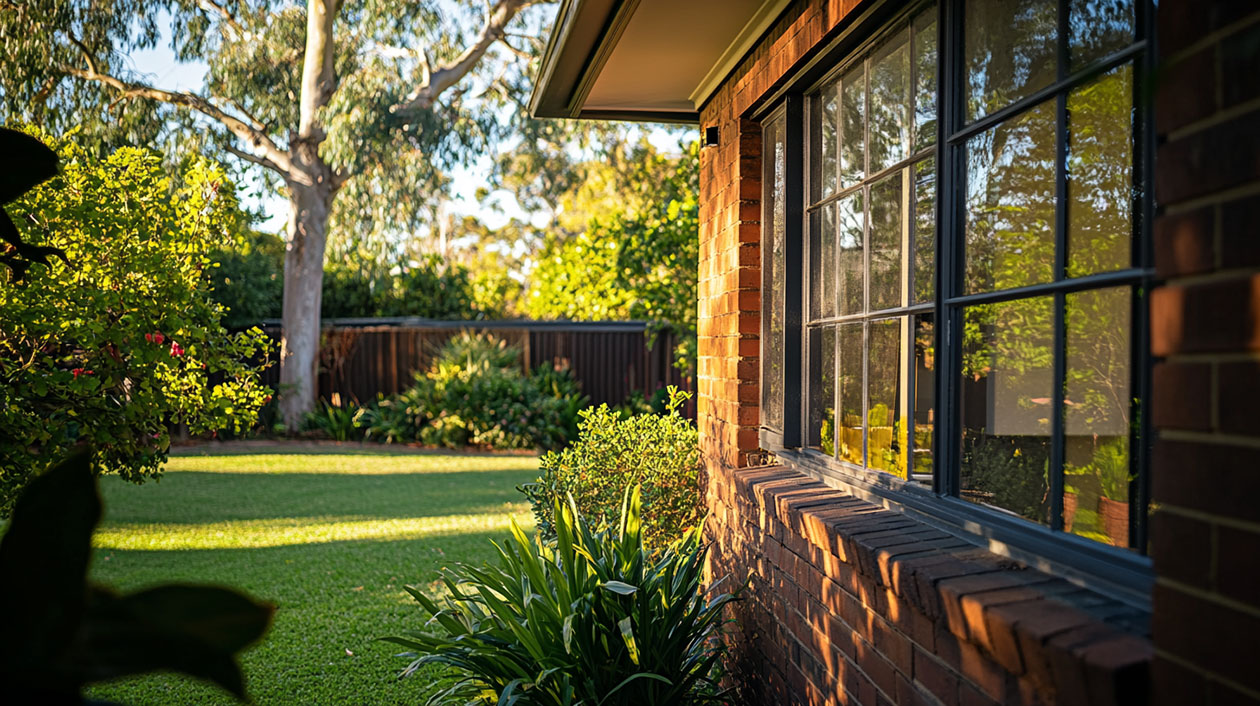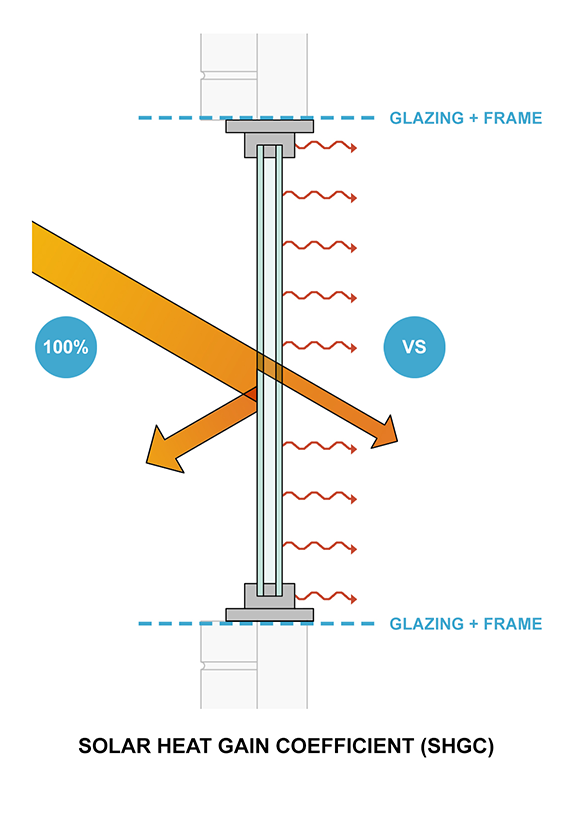
Sunlight streaming through windows provides natural light and warmth. However, it also brings heat. This heat can significantly impact your home’s temperature and energy bills. Managing this solar heat is crucial for a comfortable and energy-efficient home. This involves understanding the Solar Heat Gain Coefficient (SHGC). This guide provides a detailed explanation of SHGC. We’ll cover its importance, calculation, control, and impact on your home’s energy efficiency. Additionally, we’ll address common questions and misconceptions surrounding this essential window performance metric.
What is solar heat gain?
Solar heat gain refers to the increase in thermal energy of a space, object, or structure as it absorbs solar radiation. This phenomenon plays a significant role in building design and energy efficiency.
Solar heat gain occurs when solar radiation strikes an object or enters a space, causing it to absorb heat. This process involves:
- Absorption of solar radiation: Objects or surfaces absorb visible light and short-wave infrared components of sunlight.
- Temperature increase: The absorbed energy causes the object or surface to increase in temperature.
- Re-radiation: The heated object then re-radiates that heat at longer infrared wavelengths.
Solar heat gain is most noticeable in buildings through windows and other transparent materials. While glass allows visible light to pass through, it traps the long-wave infrared radiation re-emitted by indoor surfaces, leading to a phenomenon known as the greenhouse effect.
The solar heat gain of windows and doors is typically quantified using two main metrics:
- Solar Heat Gain Coefficient (SHGC): This measures the fraction of incident solar radiation that enters a building through the entire window assembly as heat gain. SHGC values range from 0 to 1, with lower values indicating less solar heat transmission.
- Shading Coefficient (SC): An older metric that compares the solar heat gain of a specific glazing to that of a single pane of clear glass. SHGC has largely replaced the SC in modern window design and building codes.
What is a good solar heat gain?
A “good” solar heat gain coefficient (SHGC) depends on various factors, primarily the climate and the specific needs of the building. There isn’t a one-size-fits-all answer. Consideration needs to be given to the following:
Climate Considerations
- Hot climates:
- Lower SHGC values (0.25 – 0.40) are generally preferred.
- These values help reduce cooling loads and prevent overheating.
- Cold climates:
- Higher SHGC values (0.40 – 0.60 or even higher) are often beneficial.
- These allow more solar heat gain, which can help with passive heating in winter.
- Moderate climates:
- Medium SHGC values (0.40 – 0.60) are suitable.
- These provide a balance between solar heat gain and natural light transmission.
Orientation and Placement
- South-facing windows (in the Northern Hemisphere):
- May benefit from higher SHGC values for passive solar gain.
- East and west-facing windows:
- Often require lower SHGC to minimise heat gain, especially in warmer climates.
Other Factors to Consider
- Shading: External shading devices or landscaping can impact the effectiveness of SHGC.
- Window size: Larger windows admit more solar heat, influencing SHGC choice.
- Building design: Overhangs or other architectural features can affect optimal SHGC.
Specific Examples
- For passive solar effect: SHGC values between 0.42 and 0.63 are recommended.
- For actual solar heating: Choose the highest value rating available.
- In very hot climates or for west-facing windows: SHGC as low as 0.25 might be appropriate.
It’s important to note that the “best” SHGC often involves balancing heat gain with other factors like natural light transmission and overall energy efficiency. Depending on window orientation and specific room requirements, varying SHGC values within the same building might be optimal.
What is the equation for solar heat gain?
The equation for solar heat gain can be expressed as follows:
Solar Heat Gain = (Solar Heat Gain Coefficient) × (Window Area) × (Solar Radiation)
This equation calculates the amount of solar heat that enters a space through windows or other glazed surfaces. Let’s break down each component:
- Solar Heat Gain Coefficient (SHGC): This measures how well a window blocks heat from the sun. It’s expressed as a number between 0 and 1, with lower values indicating better heat-blocking properties.
- Window Area: This is the total surface area of the window or glazed surface, typically measured in square feet or square meters.
- Solar Radiation: This is the amount of solar energy incident on the window surface, usually measured in watts per square meter (W/m²).
It’s important to note that this equation provides a simplified calculation of solar heat gain. In practice, the actual heat gain can be influenced by various factors such as:
- The angle of incidence of solar radiation
- Shading devices or landscaping
- The spectral properties of the glazing
- The orientation of the window
For a more comprehensive understanding of heat gain in a building, you would need to consider additional sources of heat beyond just solar radiation. The total heat gain formula typically includes:
Heat Gain = (Solar Heat Gain) + (Heat Gain from People) + (Heat Gain from Equipment) + (Heat Gain from Lighting)
Each component has its own calculation method, but the solar heat gain is often the most significant contributor in many buildings, especially those with large glazed areas.
When selecting windows or designing building envelopes, architects and engineers use the SHGC along with other metrics like U-factor (which measures insulation properties) and Visible Transmittance (VT) to optimise energy performance while maintaining adequate natural light and comfort levels.

Image by Daniel Overbey
How to reduce solar heat gain?
To reduce solar heat gain in buildings, there are several effective strategies you can implement:
1. Window Treatments
Installing appropriate window treatments is one of the simplest and most cost-effective ways to reduce solar heat gain:
- Internal treatments: Use blinds, shades, or curtains to block direct sunlight.
- External treatments: Install external shades or awnings, which are more effective at preventing heat from reaching the glass.
2. Glazing Solutions
Improve your windows’ ability to block heat:
- Low-emissivity (low-E) coatings: Apply these microscopic glazing applications to block solar heat from passing through windows. They can reduce energy loss by 30%-50%.
- Double or triple glazing: Replace single-pane windows with double or triple-pane models, which are more effective at reducing heat gain.
3. Shading Devices
Implement external shading solutions:
- Fixed horizontal shading: Use eaves, pergolas, or overhangs, especially for north-facing windows (in the Northern Hemisphere).
- Adjustable external shading: Install blinds, awnings, louvres, or shutters, particularly for east and west-facing windows.
4. Landscaping
Utilise natural shading:
- Plant deciduous trees: These provide shade in summer while allowing sunlight in winter.
5. Window Replacement
If your current windows are old or inefficient, consider replacing them:
- Energy-efficient windows: Choose windows with a low Solar Heat Gain Coefficient (SHGC). For example, in the North Central Zone of the US, ENERGY STAR recommends windows with an SHGC of 0.40 or lower.
6. Window Tinting
Apply window tinting to existing windows:
- These can be particularly effective for windows that can’t be easily shaded or replaced and help to reduce heat in your home.
7. Ventilation
Implement proper ventilation strategies:
- Use natural ventilation or mechanical systems to remove warm air from the building.
8. Automation
Consider automated systems:
- Link solar shading to environmental controls to optimise shading position automatically.
By combining these strategies, you can significantly reduce solar heat gain in your building, improving comfort and energy efficiency saving you on energy bills for air conditioning. The most effective approach will depend on your specific climate, building orientation, and budget constraints.
How to increase solar gain?
To increase solar heat gain in a building, you can implement several strategies:
1. Optimise window orientation:
- Install larger windows on south-facing walls (in the Northern Hemisphere) to maximise solar exposure during winter months.
2. Choose appropriate glazing:
- Select windows with a higher Solar Heat Gain Coefficient (SHGC) to allow more solar radiation to pass through.
- Consider SHGC values between 0.40 and 0.60 or even higher for cold climates.
3. Use passive solar design principles:
- Incorporate thermal mass materials like concrete or stone floors to absorb and store heat during the day.
- Design overhangs or awnings that allow low winter sun to enter but block high summer sun.
4. Minimise obstructions:
- To maximise winter solar gain, keep south-facing windows unobstructed between 9:00 AM and 3:00 PM.
- Trim trees or remove obstacles that might block sunlight from reaching windows.
5. Utilise window treatments strategically:
- Open blinds and curtains during sunny winter days to allow sunlight in.
- Close them at night to retain heat.
6. Consider sunrooms or solariums:
- Add glass-enclosed spaces that can trap solar heat and distribute it to the rest of the house.
7. Install skylights:
- Add skylights to bring in more natural light and heat from above.
8. Use reflective surfaces:
- Place reflective materials or light-coloured surfaces near windows to bounce more sunlight into the building.
9. Consider Trombe walls:
- Install a dark-coloured wall with a glass layer in front to absorb and slowly release heat into the interior.
Remember, while increasing solar gain can be beneficial in cold climates or during winter, it’s important to balance this with strategies to prevent overheating in summer.
What is a good U-value?
A good U-value for windows is generally considered to be anything below 1.6 W/m2K. Lower U-values indicate better insulation and energy efficiency. In Australia, U-value ratings for windows typically fall between 2.0-10.0 W/m2K.
Regulations require windows with a U-value of 1.4 W/m2K or lower to be installed in newly built homes in the UK.
For comparison purposes:
- Single-glazed windows have U-values around 5.0 W/m2K
- Double-glazed windows range from 1.1 to 1.6 W/m2K
- Triple-glazed windows can be approximately 0.8 W/m2K
Understanding SHGC empowers you to make informed decisions about your windows. Choosing the right SHGC is crucial for a comfortable, energy-efficient home. Consider your local climate and heating/cooling needs. By optimising your windows for solar heat gain, you can significantly reduce energy consumption and create a more comfortable living environment. Remember to balance SHGC with other important window performance factors like U-factor and visible light transmittance (VLT). A holistic approach to window selection ensures optimal performance and comfort. Need a hand with reducing your solar heat gain? Give the friendly team at EverClear Window Tinting a call today!

